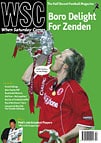 In spite of the fierceness of the clubs’ rivalry, there has been a remarkable amount of transfer activity between Newcastle and Sunderland. Joe Boyle examines the history
In spite of the fierceness of the clubs’ rivalry, there has been a remarkable amount of transfer activity between Newcastle and Sunderland. Joe Boyle examines the history
“A massive error of judgement” was how Lee Clark described the actions leading to his exit from Sunderland in 1999. Many in the north-east would go further. The error was not the infamous T-shirt he was pictured in bearing the anti-Sunderland slogan “Sad Mackem Bastards”. The error was his decision to move to Sunderland from Newcastle in the first place.
Crossing the Tyne-Wear divide was shocking because of Clark’s obsessive relationship with Newcastle. When the prodigal Geordie finally returned to St James’ Park with Fulham this January, the local press devoted pages to the reunion, while continuing to pick at the sores of his departure nearly seven years earlier. “Tonight,” gushed John Gibson in the Evening Chronicle, “we welcome a dear friend to our home.” Clark received a standing ovation from supporters formerly stunned by his defection. He left the pitch with “a lump in his throat”.
His transfer to the Stadium of Light seemed illogical because he was always overtly partisan. “The chances of Lee Clark joining Sunderland were next to nil,” says Rob Mason, the club’s programme editor. “Clark is black and white through and through.” By comparison, Michael Bridges, a contemporary of Clark at Sunderland, worked hard to conceal his allegiance to the black and white stripes, somehow creating the impression he was a Spurs fan. Similarly, throughout his years on Tyneside, Chris Waddle was coy about his Sunderland leanings, not that the crowd cared as long as he was destroying opposing full-backs.
To Newcastle fans, Clark’s move exacerbated a feeling that historically their neighbours have done better out of transfers between the two clubs. As if to prove the point, Clark’s arrival at Sunderland coincided with an England call-up and a rise in the team’s fortunes. Meanwhile, Kevin Keegan’s dynasty up the road crumbled. A year later, Newcastle signed Sunderland’s clownish French keeper, Lionel Perez. The contrast with the Clark transfer was stark.
That said, Clark is no football genius. Of the 14 who have made the move from Sunderland to Newcastle and the 16 who have gone the other way, probably only one player merits that description. Len Shackleton announced himself at Newcastle in 1946 with a double hat-trick in a 13-0 win over Newport. Yet within 18 months he had moved to Roker Park. Instead of fighting to keep him, Newcastle’s board, who considered him unreliable, hastened his departure; one board member reportedly informed a Sunderland counterpart that increasing a sealed bid by £50 would secure Shackleton’s signature. “No great animosity surrounded the transfer,” says Mason. “He was a good player at Newcastle but only became a great player at Sunderland.” Besides, the emergence of Geordie hero Jackie Milburn softened the blow.
Indifference also greeted David Young’s and Ron Guthrie’s moves to Sunderland in 1972. “They couldn’t regularly get in [Newcastle’s] side,” recalls Paul Tully, Newcastle’s publications editor, “so it caused no ripples when they left.” It caused a ripple the following year when both were part of Bob Stokoe’s 1973 FA Cup-winning squad, Guthrie playing in the final.
This is stark evidence of how transferring between the clubs can boost a player’s career, despite the accompanying suspicion and pressure. Stan Anderson, a Sunderland great in the 1950s with over 400 league appearances to his name, joined Newcastle in 1963, subsequently captaining them to promotion. Bobby Moncur made the opposite journey, joining Sunderland a year after they won the Cup in 1973 and usurping the talismanic Bobby Kerr as captain. Many players might have buckled but Moncur led Sunderland to promotion within two years. Paul Bracewell went from Sunderland to Newcastle and back again, each time adding more honours to his name. All three, ultra-professional in their approach, are fêted at both clubs.
Despite this high-class roll-call, it is significant that most transfers between the clubs have involved either fringe players or those nearing the end of their careers. Len Shackleton was surplus to requirements at Newcastle; Anderson and Moncur were nearly 30; Clark had become marginalised by Keegan. It is a noticeable contrast with the Scott Parker case. So what chance Alan Shearer in red and white next year for a final tilt at the Cup? If it worked for Ron Guthrie, Alan, it can work for you.
From WSC 206 April 2004. What was happening this month